Click on images to enlarge
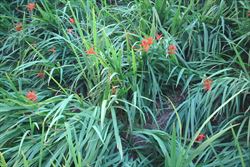
infestation (Photo: Sheldon Navie)
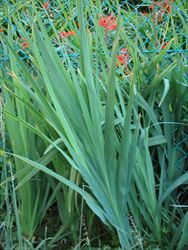
habit (Photo: Sheldon Navie)
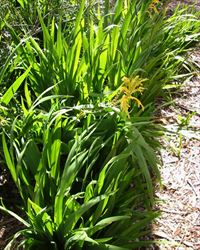
habit of yellow-flowered form (Photo: Sheldon Navie)
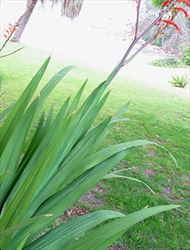
large strap-like leaves and few-branched flowering stem (Photo: Jackie Miles and Max Campbell)
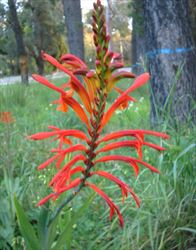
elongated flower cluster (Photo: Sheldon Navie)
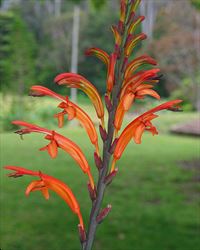
close-up of tubular flowers (Photo: Jackie Miles and Max Campbell)

yellow flowers (Photo: Sheldon Navie)
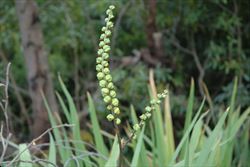
immature fruit (Photo: Rob and Fiona Richardson)
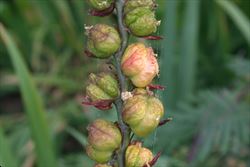
close-up of immature fruit (Photo: Rob and Fiona Richardson)
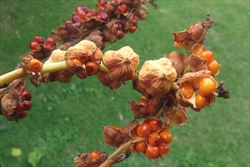
mature fruit and seeds (Photo: Ros Shepherd)
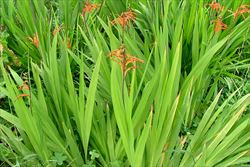
habit of the very similar Chasmanthe bicolor (Photo: Sheldon Navie)
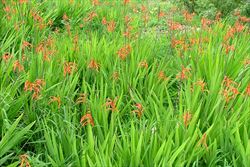
infestation of Chasmanthe bicolor in southern NSW (Photo: Sheldon Navie)
Scientific Name
Chasmanthe floribunda (Salisb.) N.E. Br.
Synonyms
Antholyza aethiopica auct. non L.Antholyza floribunda Salisb.Chasmanthe aethiopica auct. non (L.) N.E. Br.Chasmanthe floribunda (Salisb.) N.E. Br. var. duckittii G.J. Lewis ex L. Bol.Chasmanthe floribunda (Salisb.) N.E. Br. var. floribundaPentamenes aethiopica auct. non Allan
Family
Iridaceae
Common Names
African corn-flag, African cornflag, Aunt Eliza, chasmanthe, cobra lily, lion's paw, madflower
Origin
Native to southern Africa (i.e. Cape Province in South Africa).
Cultivation
African cornflag (Chasmanthe floribunda) is widely cultivated as a garden ornamental in southern Australia.
Naturalised Distribution
This species is widely naturalised in the temperate regions of southern Australia (i.e. in the coastal districts of central New South Wales, in southern and western Victoria, in Tasmania, in south-eastern and southern South Australia, and in large parts of southern and western Western Australia).
Also naturalised overseas in south-western USA (i.e. California).
Habitat
A weed of roadsides, disturbed sites, waste areas, parks, grasslands, open woodlands, coastal sites and waterways (i.e. riparian vegetation) in temperate regions.
Habit
A large herbaceous plant (0.5-1.5 m or more tall), re-growing each autumn from a long-lived (i.e. perennial) underground bulb-like storage structure (i.e. corm). These slightly-flatenned (i.e. depressed-globose) corms (4-7 cm across) are covered in papery netted fibres, which are made up of the remains of old leaf bases.
Distinguishing Features
-
a long-lived herbaceous plant (0.5-1.5 m tall), re-growing each year from underground corms.
-
the large, strap-like, leaves (80-100 cm long and 1.8-4 cm wide) are mostly clustered together near the base of the plant.
-
the upright flowering stems are topped with elongated clusters of about 20-40 flowers.
-
the orange-red, or occasionally yellow, tubular flowers have one 'petal' lobe that is much longer than the other five.
-
the capsules (10-15 mm across) contain several orange seeds (5-7 mm across).
Stems and Leaves
The upright flowering stems (i.e. scapes) are rounded (i.e. terete), hairless (i.e. glabrous) and usually have a few branches. These stems are most often purplish in colour, or occasionally greenish.
The large, strap-like or sword-shaped (i.e. lanceolate or ensiform), leaves (80-100 cm long and 1.8-4 cm wide) are mostly clustered together near the base of the plant. They are borne in an upright position (i.. are held erect) and have a prominent central vein (i.e. mid-vein). These leaves are hairless (i.e. glabrous), have entire margins and pointed tips (i.e. acute apices). There are also 1-3 smaller, alternately arranged, leaves produced along the flowering stems (i.e. scapes).
Flowers and Fruit
The elongated flower clusters (i.e. spikes) are usually 15-25 cm long and have about 20-40 flowers. The flowers (up to 7.5 cm long) are arranged in two rows on opposite sides of the flower stem. At the base of each flower is a pair of small, membranous, bracts (1-1.5 cm long). These bracts are usually reddish-brown, or occasionally green. The flowers have six 'petals' (i.e. tepals or perianth segments) that are fused together for most of their length (i.e. into a perianth tube 3-4.5 cm long). This tube is quite narrow (8-12 mm wide) near the base and have a broader, cylindrical, upper portion. The 'petals' are orange-red, or occasionally yellow, in colour and the uppermost 'petal' lobe (18-33 mm long and 7-9 mm wide) is much longer than the others (10-17 mm long and 4-7 mm wide). The three anthers (7-8 mm long) are held outside the flower tube (i.e. they are exserted) and are borne on stalks (i.e. filaments) 5-5.5 cm long. At the base of the flower tube is the ovary (6-9 mm long), which is topped with a long style. The style is divided into three branches near its tip, each branch topped with a stigma. Flowering occurs mostly during winter and spring (i.e. from July to October).
The fruit is a capsule (10-15 mm across) that is irregularly rounded in shape (i.e. irregularly globose). Each capsule contains several (6-10) large, rounded, orange seeds (5-7 mm across) that have a smooth surface texture.
Reproduction and Dispersal
This species reproduces by seed and also vegetatively via its underground corms. These corms can regularly produce smaller corms (i.e. cormlets) around each parent corm.
The seeds and corms are spread in dumped garden waste and contaminated soil. The seeds are also dispersed by birds and water.
Environmental Impact
African cornflag (Chasmanthe floribunda ) is a significant environmental weed in Victoria, South Australia and Western Australia. It is also regarded as a minor environmental weed or sleeper weed in Tasmania and New South Wales.
This garden escape often becomes naturalised along roadsides and in waste areas, from where it spreads into urban bushland, open woodlands and grasslands. These populations are thought represent a serious threat to grassy woodlands, dry and damp sclerophyll forests and riparian vegetation in Victoria and throughout south-western Western Australia. It has been present for some time in several conservation sites in south-eastern South Australia (e.g. Moana Sands Conservation Park, Ferguson Conservation Park and Sandy Creek Conservation Park).
Legislation
Not declared or considered noxious by any state government authorities.
Similar Species
There are two forms of this species present in Australia, and they are sometimes regarded as two distinct varieties. The more common form has orange or red flowers (i.e. Chasmanthe floribunda var. floribunda), while the less common form has yellow flowers (i.e. Chasmanthe floribunda var. duckittii).
African cornflag (Chasmanthe floribunda) is very similar to Chasmanther bicolor and relatively similar to montbretia (Crocosmia x crocosmiiflora) and bulbil watsonia (Watsonia meriana var. bulbillifera). These species can be distinguished by the following differences:
- African cornflag (Chasmanthe floribunda) is a relatively large plant (usually about 1.5 m tall) with relatively large leaves (more than 80 cm long) that are usually 20-40 mm across. Its yellow, orange or red flowers have three stigmas and the uppermost petal (i.e. corolla lobe) is significantly longer than the others.
- Chasmanthe bicolor is a relatively small plant (up to 1 m tall) with relatively large leaves (more than 80 cm long) that are usually 20-40 mm across. Its flowers are bright reddish-orange striped with light green or yellow, have three stigmas, and the uppermost petal (i.e. corolla lobe) is significantly longer than the others.
- montbretia (Crocosmia x crocosmiiflora) is a relatively small plant (usually less than 60 cm tall) with relatively small leaves (30-80 cm long) that are rarely more than 20 mm across. Its yellow, orange or red flowers have three stigmas and all of the petals (i.e. corolla lobes) are about the same size.
- bulbil watsonia (Watsonia meriana var. bulbillifera) is a relatively large plant (usually 1-1.8 m tall) with relatively large leaves (50-80 cm long) that are usually 20-50 mm across. Its salmon pink flowers have six stigmas and all of the petals (i.e. corolla lobes) are about the same size. It rarely produces fruit (instead it produces clumps of distinctive 'cormils' or 'bulbils' at the upper stem joints).

